It’s gloomy, rainy and time for a museum, the Natural History Museum in Balboa Park. We’ve visited most of the museums in Balboa over the 3 years we have stayed but not this one. Probably natural history is not my favorite - it’s civic, social, economic and political history that are. But we can learn from all museums so we’re off.
We first saw a neat film about sharks in 3-D. Hmmm 3-D and sharks. Maybe I don’t want to see this. However, it was amazingly well done and played not to fear in people’s souls but to sympathy. It was narrated by a small turtle (how can a film narrated by a turtle by scary?) and featured various types of sharks in their native habitat. The theme of the movie was that sharks are not normally dangerous to humans but that humans are extraordinarily harmful to sharks.
Funny thing happened after the movie as we were walking to the next section of the museum. A yellow banner protecting a new exhibit fell down and the young boy next to it immediately pointed to a young girl near him and said; ‘she did it.’ He was fast.
Most of the museum was actually natural history but there were several sections that were particularly interesting. One room was devoted to the use of water in California. There is not enough water in southern California for all of the people who are here now and who continue to stream in. Nor is there enough water in central California to grow all the crops there which are shipped throughout the world. Much of the water used in southern California comes from the Colorado River and there was a very graphic map on the wall showing this.
Obviously the funnels are mountains with lots of spring runoff which turns into rivers. The two round balls are the two dams on the Colorado River, the Glen Canyon Dam and the Hoover Dan in Nevada. Finally, the faucets are - ta da!! - southern California, Phoenix and Tucson. See that little girl in the lower right, she represents the Cucapa tribe which lives on the Colorado Delta and have for thousands of years. Today, they have to truck water in since none flows to the delta. The Colorado River Compact was drawn up in 1922 to distribute the water of the Colorado based upon the flow levels of the preceding decade, the wettest in history.
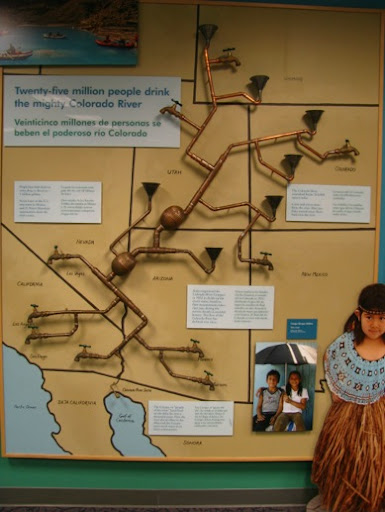
Transporting water in CA uses more energy than any other activity. An estimated 19% of the energy used in CA is used for water collection, transportation and treatment. On hot days sometimes 70% of the water is evaporated as it is transported in canals to its final destination. Here is a picture of a canal transporting water from the mountains to the cities in the valleys. These canals are long, they are wide and they cover the countryside. They snake across Arizona and Californa. But they make it possible to grow vegetables in an arid climate and they allow more people to live here than could be supported by rainfall.
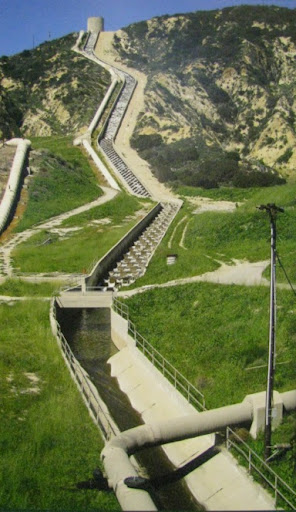
You probably know this but it strikes me every time. Over 70% of the earth is water but 97% of this is ocean water and thus too salty to drink. Another 2 % is in ice or deep underground. That means that only 1% of the world’s water is useful for drinking and irrigation.
The other room which we enjoyed was the room which highlighted minerals and elements. We were intrigued by how gold looks in the ‘raw’.
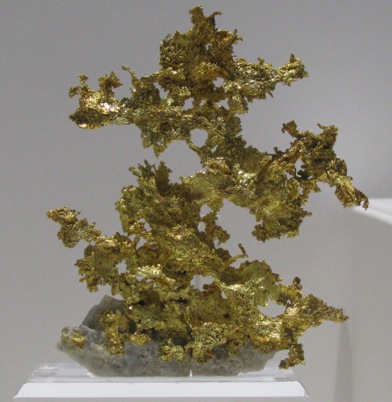
And here is a picture of the giant crystals of selenite in a mine in Mexico. For thousands of years, hot mineral-rich water flowed into the cavern and large crystals grew. In 1985, miners, pumping out adjacent mines, unknowingly pumped this mine dry and the crystals stopped forming. These caves are still extremely humid and, even with protective clothing, as the people here have on, with temperatures reaching 112 degrees, heat stroke can occur rapidly.
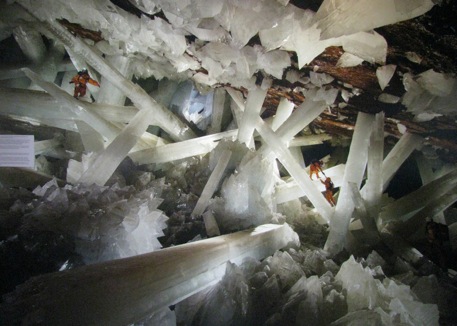
However, most of the room was devoted to gems and jewelry.
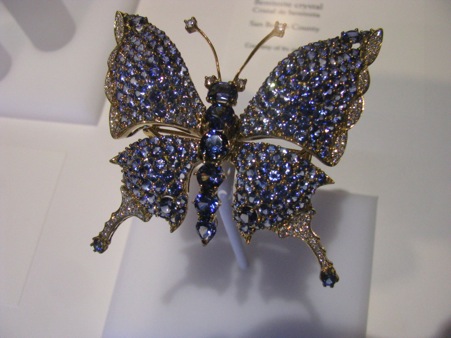
Of course, the women were all intrigued by this stunning piece of jewelry. It was strategically placed so you could ‘wear’ it virtually. I’m thinking it might be a bit chilly.
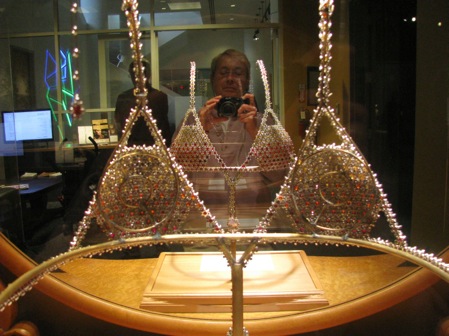
Scientists have analyzed meteorites which have fallen to earth and have discovered that they have no different minerals than we have on earth itself - so far. Isn’t that amazing? As far as science know, there are no elements in outer space that are not here on earth. Isn’t that something?
And, finally, here’s something I’ve never seen and we found this in a cooler in the gift shop. Only in California - but I hope this comes nationwide. Boxed water is much better for the environment but is probably less convenient.
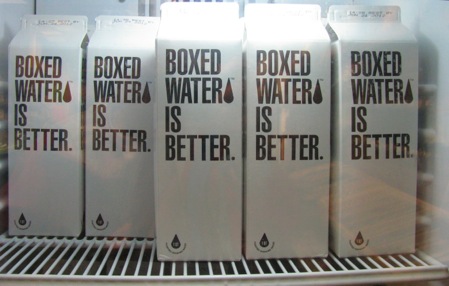
Afterwards, we walked around the ground of Balboa Park which is really beautiful. Beaautiful natural setting among and utilizing the canyons of San Diego and dotted with marvelous museums. However, one of the things I always remember the most is how close planes come in as they approach their landing at the San Diego airport. They fly so low above the apartments and condos abutting Balboa Park that they probably can see what people are having for breakfast.
In the evening I got everything ready to begin doing our taxes when I have some time. Then, since I had some time before we went to bed, I thought I’d start them to see how far I could go. We do our bookkeeping in Quicken and we do our taxes on Turbo Tax and I thought these two would help me get them organized better.
THEY’RE ALL DONE!!! They went much faster than I thought. They aren’t too difficult, it’s all in Quicken and our statements. However, we'll wait til we have some time to review them before we electronically send them in. We love the ease of Turbo Tax. So much easier than pencil and paper.
I read today that The IRS when put together says ‘theirs.
Yippee!!

No comments:
Post a Comment